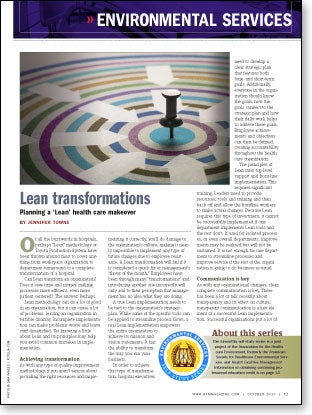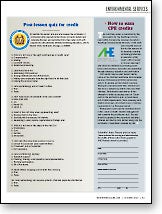Lean transformations

Of all the buzzwords in hospitals, perhaps "Lean" methodology or Toyota Production System have been thrown around most to cover anything from workspace organization to department turnaround to a complete transformation of a hospital.
Can Lean transform an organization? Does it save time and money, making processes more efficient, even more patient centered? The answer: Perhaps.
Lean methodology can do a lot of good in an organization, but it can cause a lot of problems, leaving an organization in terrible disarray. Incomplete implementation can make problems worse and leave staff dissatisfied. Yet knowing a little about Lean and its principles may help you avoid common mistakes in implementation.
Achieving transformation
As with any type of quality improvement methodology, if you aren't serious about providing the right resources and implementing it correctly, you'll do damage to the organization's culture, making it nearly impossible to implement any type of future changes due to employee resistance. A Lean transformation will fail if it is considered a quick fix or management's "flavor of the month." Employees have been through many "transformations" and introducing another one incorrectly will only add to their perception that management has no idea what they are doing.
A true Lean implementation needs to be tied to the organization's strategic plan. While some of the specific tools can be applied to streamline process flows, a real Lean implementation empowers the entire organization to achieve its mission and vision statements. It has the ability to transform the way you run your business.
In order to achieve that type of transformation, hospital executives need to develop a clear strategic plan that features both long- and short-term goals. Additionally, everyone in the organization should know the goals, how the goals connect to the strategic plan and how their daily work helps to achieve these goals. Employee achievements and objectives can then be defined, creating accountability throughout the health care organization.
The principles of Lean infer top-level support and front-line implementation. This requires significant training. Leaders need to provide resources, tools and training and then back off and allow the frontline workers to make actual changes. Because Lean requires this type of investment, it cannot be successfully implemented if one department implements Lean tools and the rest don't. If used for isolated processes, or even overall departments, improvements may be realized but will not be sustained. It is not enough for one department to streamline processes and improve service if the rest of the organization is going to do business as usual.
Communication is key
As with any organizational changes, clear, complete communication is key. There has been a lot of talk recently about transparency and its effect on culture; transparent communication is a key element of a successful Lean implementation. Successful organizations put a lot of time and effort into translating Lean principles for employees. Reasons for the implementation, what to expect during the change process and what outcomes are expected, need to be spelled out in common terms. When employees are left in the dark about changes that affect their daily work, concepts will get misconstrued and rumors will start to fly.
Communication is also needed to gain the employee support necessary for successful transformation. Resistance to change will grow if employees aren't confident in the direction and purpose of their work. For instance, very common to implementing Lean is the notion that people are going to lose their jobs. Many workers have probably been through past "improvement" methodologies and were downsized as a result. It is completely natural for them to assume the same thing will occur with a Lean transformation.
The downsizing issue is so critical to successful implementation that many hospital CEOs have made promises to employees that no one will lose their jobs because of the changes and they repeat this message at all staff meetings and status updates. This is not to say that people's job responsibilities will not change. By its very nature, Lean infers that daily work will be different. However, it may also afford employees more challenges and opportunities.
Training and implementation
Once planning is finished and ideas have been communicated throughout the organization, it is time for training and implementation. While many Lean tools seem simple and only require common sense, they are in fact difficult to use properly. For this reason, it is necessary to train employees.
There are two other considerations when implementing Lean. First, leaders need to decide whether to hire a consultant. Hiring a consultant that specializes in Lean for health care can be advantageous, since this person should have experience with the nuances of the health care industry. However, sending people to become educated and trained in Lean methodologies and tools may help champion the change in the organization.
Further, organizations should appoint a Lean champion. This person will lead initiatives, remove barriers by communicating directly with executive management and assist in garnering employee support.
With planning, communication and training completed, it is time to conduct a Lean event. Lean's basic concept is removing waste from the process. In turn, waste is described as anything of non-value to the customer. If the customer wouldn't pay for it, it's considered an inefficiency. In health care, there are eight different types of inefficiencies. They include the following:
Excessive processing. Multiple bed moves and retesting;
Overproduction. Blood draws done early to accommodate extra diagnostic tests;
Transportation. Moving patients to tests at wrong times;
Defects. Redraws, medication errors or label errors;
Inventories. Patients waiting for bed assignments or dictation waiting for transcription;
Movement. Looking for patients or searching for missing medications, charts and equipment;
Waiting. Inpatients waiting in the emergency department, patients waiting for discharge or physicians waiting for test results; and
Underutilization. Physicians transporting patients or equipment empty because of upstream bottlenecks.
 |
| Click the above image for the Post-lesson quiz for credit |
Overall, there are nearly 30 different tools that apply to the process improvement exercise, some easier to implement than others. For example, "Five S" is a tool for organizing and cleaning up environments. The Five S's — sorting, straightening, shining, standardizing and sustaining — will determine how things are stored. In health care, this is sometimes referred to as "Six S's," with safety being the additional "s." The idea is that when things are in their place and everyone knows where that place is, inefficiencies are removed because employees won't be searching for items, and items won't be contaminated because they were stored incorrectly.
On the opposite end of the tool spectrum, value stream mapping is more difficult. The exercise is straightforward, but it takes a lot of time and energy to get it right. First, the team needs to draw a map of the current state. This will require going to the floor and finding out the actual process. Don't rely on written processes and even memory; shadowing front-line staff is the only way to know. Areas that need improvement will stand out if the value stream map is done correctly. The next step is to draw a map of the future state, with the goal of the Lean project in mind. Inefficiencies are removed from the overall process because the team is searching for more efficient ways to get to the end goal and questioning each step in the process.
Moving forward
As with any successful tool, the term Lean gets applied to many quality improvement projects, big and small. However, in order for Lean to be successful in an organization, it can't be implemented as a way to improve one process within an isolated division of an organization. Yes, Lean has the ability to assist in improving that process, but its real power lies in total transformation of the entire organization.
Lean is an effective tool to help hospital leaders improve quality of care within the current constraints in which all hospitals operate. But only an effective implementation, focusing on executive leadership and frontline staff empowerment, will unleash the true power of Lean transformation and sustain those changes. HFM
Jennifer Towne is director of content and knowledge management for the American Hospital Association's platform, "Hospitals in Pursuit of Excellence." She can be contacted via e-mail at jtowne@aha.org.
| Sidebar - St. Louis hospital employs 'Lean' tools |
| The American Hospital Association's platform, "Hospitals in Pursuit of Excellence," highlights organizations employing "Lean" tools to improve different processes, especially ones dealing with patient throughput. Back in mid-2005, St. John's Mercy Medical Center, St. Louis, worked on improving wait times in the hospital's inpatient rehabilitation center. Patients were waiting a long time for rehab and satisfaction rates were low. The organization decided to gather a multidisciplinary team of therapists, nurses and transport personnel, train them in Lean methodology and empower them to make changes to increase patient satisfaction with the process. The idea to use Lean tools came from a board member and was applied throughout the hospital by the CEO; implementation was not isolated to one department or unit. By using Lean tools, such as value stream mapping, problems around scheduling and coordinating scheduling became evident. The Lean team found 31 steps from the time a therapy order was written to when the patient returned to his or her room. They were able to reduce that to 12 steps, with frontline workers taking charge and implementing the changes. The results were dramatic: •Median wait times for acute therapy dropped 54 percent, from 24 minutes in January 2008 to 11 by September 2008; St. John's Mercy continues to employ Lean tools to process improvements. The entire case study, along with other successful examples, can be found at www.hpoe.org. |




